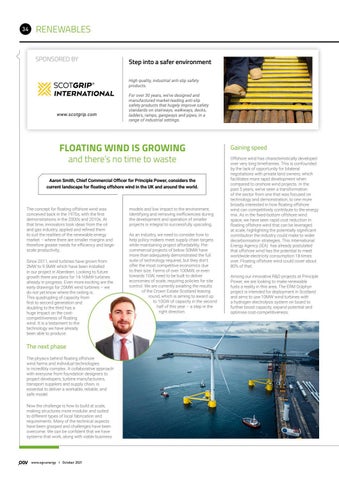34
RENEWABLES SPONSORED BY
Step into a safer environment High quality, industrial anti-slip safety products.
www.scotgrip.com
For over 30 years, we’ve designed and manufactured market-leading anti-slip safety products that hugely improve safety standards on stairways, walkways, decks, ladders, ramps, gangways and pipes, in a range of industrial settings.
FLOATING WIND IS GROWING and there’s no time to waste
Aaron Smith, Chief Commercial Officer for Principle Power, considers the current landscape for floating offshore wind in the UK and around the world.
The concept for floating offshore wind was conceived back in the 1970s, with the first demonstrations in the 2000s and 2010s. At that time, innovators took ideas from the oil and gas industry, applied and refined them to suit the realities of the renewable energy market – where there are smaller margins and therefore greater needs for efficiency and largescale productivity. Since 2011, wind turbines have grown from 2MW to 9.5MW which have been installed in our project in Aberdeen. Looking to future growth there are plans for 14-16MW turbines already in progress. Even more exciting are the early drawings for 20MW wind turbines – we do not yet know where the ceiling is. This quadrupling of capacity from first to second generation and doubling to the third has a huge impact on the costcompetitiveness of floating wind. It is a testament to the technology we have already been able to produce.
The next phase The physics behind floating offshore wind farms and individual technologies is incredibly complex. A collaborative approach with everyone from foundation designers to project developers, turbine manufacturers, transport suppliers and supply chain, is essential to deliver a workable, reliable, and safe model. Now the challenge is how to build at scale, making structures more modular and suited to different types of local fabrication and requirements. Many of the technical aspects have been grasped and challenges have been overcome. We can be confident that we have systems that work, along with viable business
www.ogv.energy I October 2021
models and low impact to the environment. Identifying and removing inefficiencies during the development and operation of smaller projects is integral to successfully upscaling. As an industry, we need to consider how to help policy makers meet supply chain targets while maintaining project affordability. Precommercial projects of below 50MW have more than adequately demonstrated the full suite of technology required, but they don't offer the most competitive economics due to their size. Farms of over 100MW, or even towards 1GW, need to be built to deliver economies of scale, requiring policies for site control. We are currently awaiting the results of the Crown Estate Scotland leasing round, which is aiming to award up to 10GW of capacity in the second half of this year – a step in the right direction.
Gaining speed Offshore wind has characteristically developed over very long timeframes. This is confounded by the lack of opportunity for bilateral negotiations with private land owners, which facilitates more rapid development when compared to onshore wind projects. In the past 5 years, we’ve seen a transformation of the sector from one that was focused on technology and demonstration, to one more broadly interested in how floating offshore wind can competitively contribute to the energy mix. As in the fixed-bottom offshore wind space, we have seen rapid cost reduction in floating offshore wind that can be leveraged at scale, highlighting the potentially significant contribution the industry could make to wider decarbonisation strategies. This International Energy Agency (IEA) has already postulated that offshore wind has the potential to meet worldwide electricity consumption 18-times over. Floating offshore wind could cover about 80% of that. Among our innovative R&D projects at Principle Power, we are looking to make renewable fuels a reality in this area. The ERM Dolphyn project is intended for deployment in Scotland and aims to use 10MW wind turbines with a hydrogen electrolysis system on board to further boost capacity, expand potential and optimise cost-competitiveness.



























